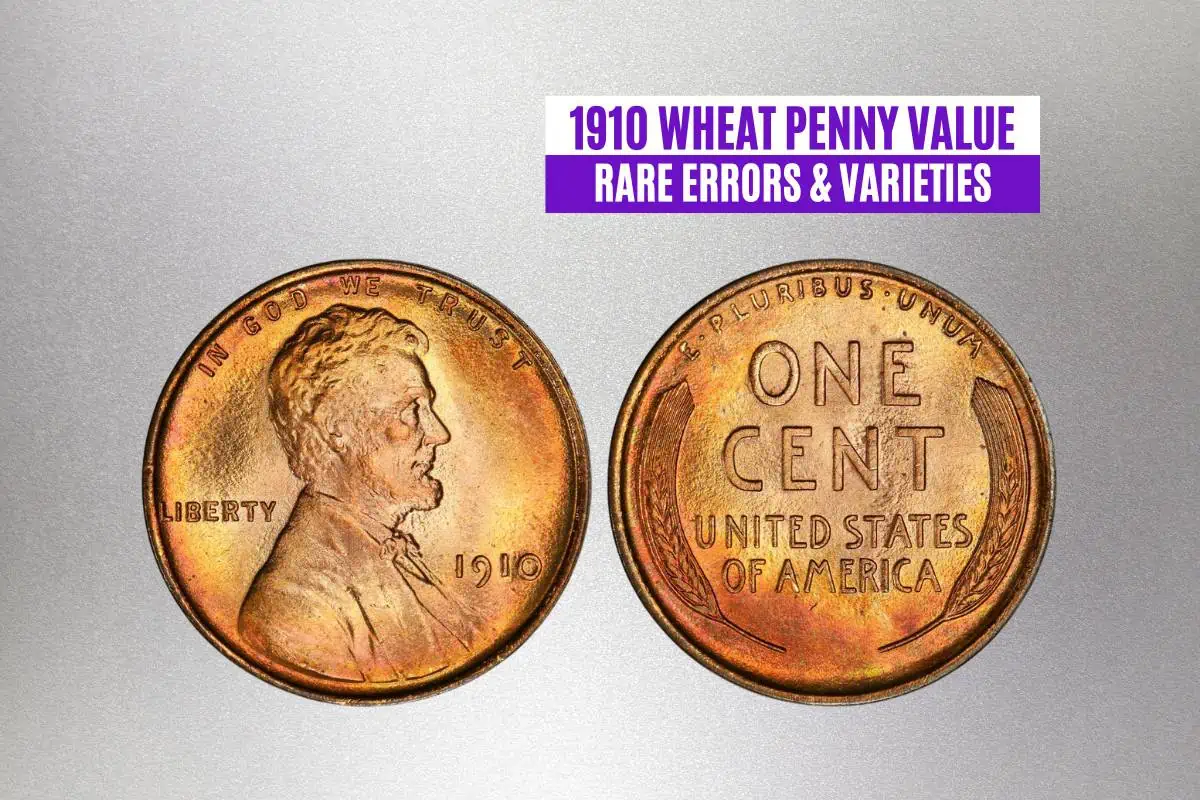Although all U.S. one-cent coins have a listed denomination of $0.01, many are worth far more thanks to their rarity, high copper content, or historical significance. The 1910 Lincoln Wheat cent checks all these boxes, and the 1910 penny value far exceeds $0.01.
If you’re a coin collector looking to add one of these coins to your collection (or estimate how much your current 1910 pennies are worth), this guide will help you discover everything you need to know about the 1910 Wheat Reverse cent.
1910 Lincoln Wheat Penny Value Chart
| Variety | MS/PR-64 | MS/PR-65 | MS/PR-66 |
| 1910-P Penny BN | $52.5 | $110 | $235 |
| 1910-P Penny RB | $80 | $150 | $490 |
| 1910-P Penny RD | $165 | $285 | $825 |
| 1910-S Penny BN | $195 | $295 | / |
| 1910-S Penny RB | $275 | $450 | $1,080 |
| 1910-S Penny RD | $440 | $840 | $2,050 |
| 1910-P Proof Penny BN | $598 | $910 | $1,250 |
| 1910-P Proof Penny RB | $845 | $1,090 | $1,440 |
| 1910-P Proof Penny RD | $1,150 | $1,380 | $2,500 |
1910 Lincoln Wheat Penny: History
In 1909, the U.S. Mint changed the design of its one-cent coin. While pennies produced before 1909 featured the Indian Head design, those produced from 1909 to 1958 featured the Lincoln Wheat (also called Wheat Reverse) design.
This new design, created by Victor David Brenner, featured the image of President Abraham Lincoln on its obverse (front) face and two wheat stalks on its reverse (back) face. The wheat on the reverse side would eventually give this coin its colloquial nickname; the Wheat penny.
However, while the 1910 Lincoln Wheat penny was identical to the 1909 version in several ways, there are two notable differences. Firstly, the 1910 Wheat Reverse cent lacked the “VDB” initials found on several of the earliest 1909 pennies. Secondly, the date was changed to reflect the new year (from 1909 to 1910).
Still, the design mostly remained unchanged between late 1909 and 1910.
1910 Lincoln Wheat Penny: Design
The 1910 Lincoln Wheat cent features the Wheat Reverse design. This design is one of the easiest ways to identify a 1910 Wheat penny. Let’s explore the hallmarks of this penny’s obverse (front) and reverse (back) sides to make it easier for you to identify this coin.
Obverse
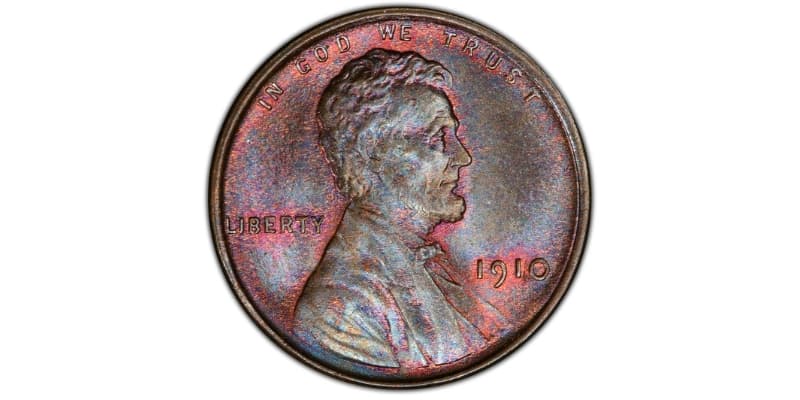
The obverse side of the 1910 Lincoln Wheat penny features:
- The motto “IN GOD WE TRUST” at the top of the coin, arching with sides downward
- The raised image (device) of Abraham Lincoln, face in profile facing the right side of the coin
- The legend “LIBERTY” on the left side of the coin, slightly below the center, almost parallel with Lincoln’s collar
- The year date “1910” on the lower right side of the coin, just below Lincoln’s bow tie
- The mint mark (S) below the year date (with the exception of coins minted at the Philadelphia Mint facility, which lack a mint mark)
Reverse
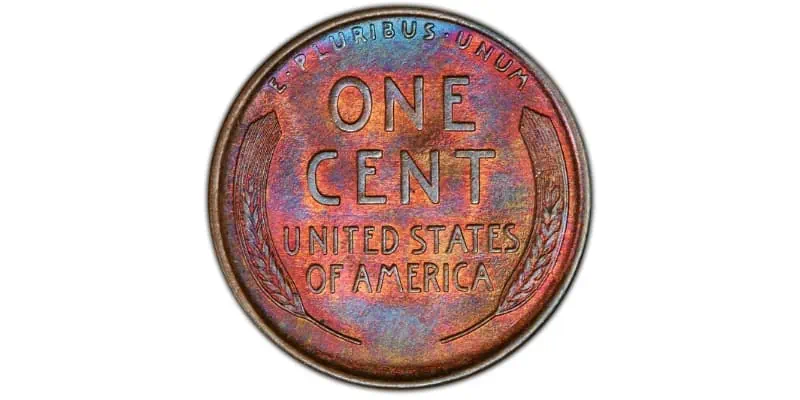
The reverse side of the 1910 Lincoln Wheat penny features:
- The motto “E PLURIBUS UNUM” at the top of the coin, arching with sides downward, separated by interpoints
- The coin denomination “ONE CENT” beneath the uppermost motto, extending to just above the midpoint of the coin
- The issuing nation “UNITED STATES OF AMERICA” beneath the coin denomination
- Two raised images (devices) of wheat stalks, each extending around the issuing nation and part of the coin denomination
1910 Lincoln Wheat Penny: Features and Specifications
1910 Lincoln Wheat pennies have some common characteristics, including weight, size, and metal composition. For example, all 1910 Lincoln Wheat pennies (regular strike and proof strike):
- Weigh 3.11 grams (about 0.11 ounces)
- Have a diameter of 19 millimeters (about 0.75 inches)
- Are 95% copper and 5% zinc and tin
Additionally, pennies have plain (smooth, without ridges) edges, unlike quarters and dimes.
How Much Is a 1910 Lincoln Wheat Penny Worth?
A circulated 1910-P (No Mint Mark) Lincoln Wheat penny is worth about $0.25 in good (G-4) condition. In about uncirculated (AU-50) condition, this penny has an estimated value of about $9. In uncirculated (mint state) condition, a 1910 Lincoln Wheat penny is worth $235 (MS-66).
1910 Lincoln Wheat Penny: Value Comparison
The value of any given 1910 Lincoln Wheat penny varies depending on its:
- Mint mark
- Condition (NGC or PCGS grade)
- Coloration (brown, red and brown, red)
- Type (regular strike or proof)
To determine which 1910 Lincoln Wheat cent has the highest (and lowest) values, let’s quickly compare these coins based on the above qualities.
1910 No Mint Mark Lincoln Wheat Penny Value
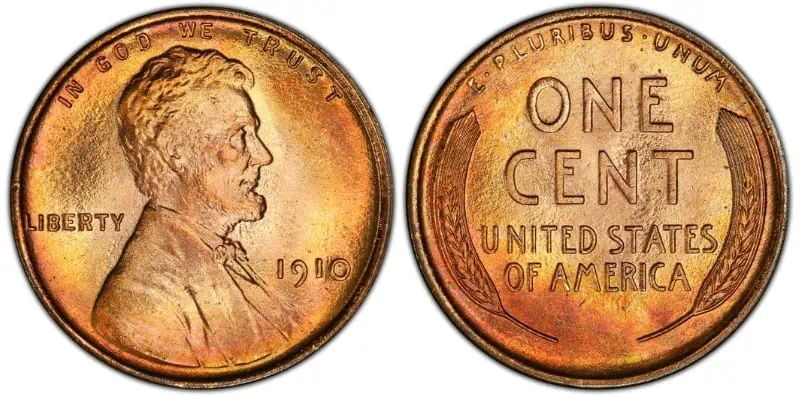
Although some unscrupulous coin sellers might attempt to convince novice numismatists (coin collectors) that 1910 pennies without a mint mark are rare, the opposite is true.
These coins lack a mint mark because they were struck at the Philadelphia Mint. In 1910, the Philadelphia Mint struck more than 146 million pennies, far more than the San Francisco Mint facility. Consequently, regular strike “No Mint Mark” 1910 Wheat Reverse pennies are more common than any other type.
That said, the average value of these pennies exceeds their listed denomination of $0.01! This is especially true of 1910-P Lincoln Wheat pennies with a bright red coloration.
Brown
Brown (BN) pennies get their color from oxidization, as the copper they contain slowly turns brown after exposure to the oxygen in the air. These cents are often heavily circulated, making them slightly less valuable than coins that have spent most of their lives in well-maintained collections.
A brown 1910 “No Mint Mark” Lincoln Wheat penny is worth about $0.25 in good (G-4) condition. In about uncirculated (AU-50) condition, a BN 1910 Lincoln Wheat cent is worth about $9.
The most valuable BN 1910-P Wheat Reverse cent is one in mint state (MS-66) condition. One of these pennies has an estimated value of $235.
Red and Brown
Red and brown (RB) pennies might have seen limited circulation before entering a private collection. They’re not quite as pristine as red (RD) pennies, but they’re also not as dark and heavily used as brown (BN) ones. Consequently, RB pennies are often in mint state (MS-60 or higher) condition.
The value of an RB 1910 “No Mint Mark” Lincoln Wheat penny varies between $19 (MS-60) and $490 (MS-66).
Red
Like RB pennies, red (RD) 1910 “No Mint Mark” Lincoln Wheat pennies are typically found in mint state (MS-60 or higher) condition. Their coloration is a fantastic indication of their condition, as they’re only able to retain this copper-red color due to limited exposure and circulation.
An RD 1910 “No Mint Mark” Lincoln Wheat cent has a value ranging between $24 (MS-60) and $10,350 (MS-67+). An MS-66 RD 1910-P Lincoln Wheat penny has an estimated value of about $825.
1910-S Lincoln Wheat Penny Value
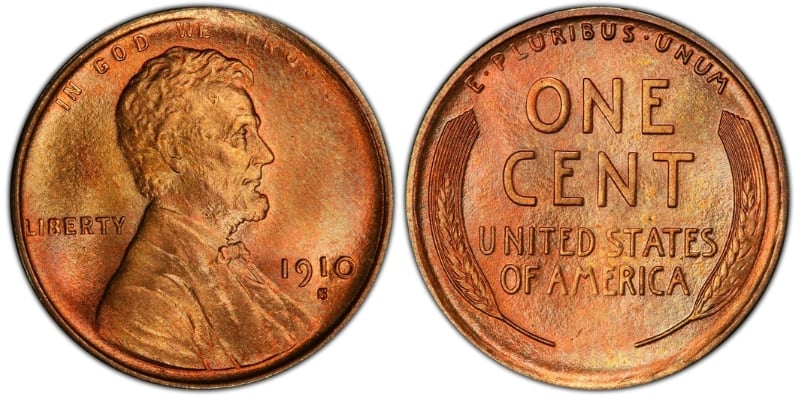
The San Francisco Mint was the only other U.S. Mint facility to produce pennies in 1910. As a result, the only mint mark found on pennies from this year is a capital “S” found beneath the year date.
The San Francisco Mint struck just over 6 million pennies in 1910. This is only about 4% of the total pennies produced by the Philadelphia Mint in 1910!
As you might expect, this lower mintage makes 1910-S Lincoln Wheat cents rarer than those without a mint mark (the only exception being proof coins struck at the Philadelphia Mint). Even heavily circulated brown (BN) 1910-S pennies are worth more than their mint-mark-free counterparts.
Brown
A brown (BN) 1910-S Lincoln Wheat penny is worth $14 in good (G-4) condition. In about uncirculated (AU-50) condition, a BN 1910-S Wheat Reverse cent has an estimated value of $75. The most valuable BN 1910-S pennies are those in uncirculated (mint state) condition.
An MS-65 example has an approximate value of $295, and an MS-66 example sold on eBay in 2021 for $1,200.
Red and Brown
A red and brown (RB) 1910-S Lincoln Wheat penny is worth $120 in MS-60 condition. But an MS-66 1910-S Lincoln Wheat penny is estimated at $1,080. For perspective, that’s 108,000 times more than its listed denomination of $0.01!
Red
Red (RD) 1910-S Lincoln Wheat pennies are generally mint state (MS-60 or higher) coins with comparatively high values. An MS-61 RD 1910-S Lincoln Wheat cent is estimated at $150, while an MS-66 example can be worth $2,050 or more.
If you’re fortunate enough to find an MS-67 RD 1910-S Lincoln Wheat cent, you’ll be happy to know that its estimated value is $13,200. In fact, an MS-67 RD 1910-S Lincoln Wheat penny is worth slightly less than a proof strike RD PR-67 1910 penny!
1910 Proof Lincoln Wheat Penny Value
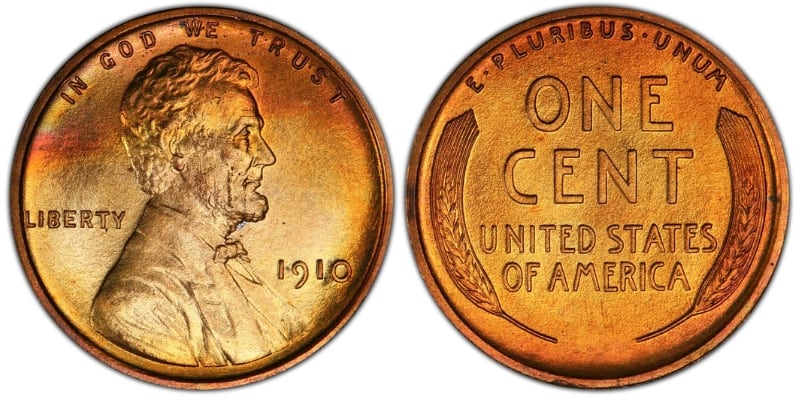
The Philadelphia Mint facility struck fewer than 3,000 proof pennies in 1910. Unlike regular strike coins, these pennies were explicitly designed for collectors, with most (if any) never entering circulation.
Consequently, the 1910 Proof Lincoln Wheat penny is almost always in exceptional condition. That said, time has impacted these coins in much the same ways as other 1910 pennies, with some turning brown due to oxidation.
Brown
A brown (BN) 1910 Proof penny in PR-60 condition is worth about $390. One in PR-66 condition has an estimated value of about $1,250. Red and brown (RB) and red (RD) proof strike pennies from 1910 are worth far more.
Red and Brown
A red and brown (RB) 1910 Proof Lincoln Wheat penny is worth $585 in PR-62. One in slightly better condition (PR-66) has an estimated value of $1,440. But an RB 1910 Proof Wheat Reverse cent with a grade of PR-67 has an approximate value of $4,750.
Red
Red (RD) 1910 Proof Lincoln Wheat pennies can be quite valuable. An PR-63 example is worth about $845, while an PR-66 RD 1910 Proof penny can be worth $2,500 or more.
Still, an PR-67 RD 1910 Proof Lincoln Wheat cent is even more valuable, estimated at $15,000.
1910 Lincoln Wheat Penny: Rare Errors
The U.S. Mint does everything possible to ensure every planchet (metal disc) becomes a high-quality coin. But this doesn’t always happen, and simple mistakes can lead to the creation of unique error coins. This is true of coins struck today and undoubtedly true of coins struck in the early 20th century!
When discussing 1910 Lincoln Wheat pennies, there are several error coins to mention. These coins include the following:
- The 1910 Lincoln Wheat Struck Through Error Penny
- The 1910 Lincoln Wheat Planchet Lamination Error Penny
- The 1910 Lincoln Wheat Doubled Die Obverse (DDO) Error Penny
- The 1910 Lincoln Wheat Die Crack Error Penny
Let’s discuss each of these error coins to find out what makes them special and how much they’re worth.
1910 Lincoln Wheat Struck Through Error
Struck-through coins typically have blurred designs resulting from physical objects (lubrication oils or fabrics) coming between the planchet and coin die. Struck-through 1910 Lincoln Wheat pennies have non-standardized appearances, though noticeable “blurs” are these error coins’ main characteristic.
A struck-through 1910 Lincoln penny can sell online for between $100 and $3,200. Naturally, coins in mint state condition (MS-60/PR-60 or higher) tend to outsell heavily circulated coins in good condition.
1910 Lincoln Wheat Planchet Lamination Error
The shiny exterior of a coin is the result of careful lamination. But, like laminated paper, the lamination layer can flake off if it’s improperly applied. This is the case with planchet lamination error coins.
Identifying lamination error coins can be challenging, as they resemble die-crack coins. This means they have cracks in their surfaces. Still, a coin grading company (like PCGS or NGC) can help you determine the precise nature of an error coin.
Planchet lamination error 1910 Lincoln Wheat pennies can sell online for between $20 and $300. As with other coins, coloration and condition significantly impact value.
1910 Lincoln Wheat Doubled Die Obverse (DDO) Error
The doubled die obverse (DDO) coin error is exceptionally common, with there typically being a few DDO coins belonging to each mintage year. Unlike double-strike coins (which feature a doubled image due to multiple die strikes), a DDO coin almost always results from a coin die error.
So, if the coin die used to press a coin has a doubled element (like the date or motto), this doubling will appear after only a single strike.
A 1910 Lincoln Wheat penny with a DDO error can sell for between $10 and $200, depending on the severity of the design doubling and the coin’s overall condition.
1910 Lincoln Wheat Die Crack Error
The coin dies that impress images into planchets can develop cracks and design errors due to prolonged use. When this happens, the resulting coins feature the same signs of damage as the die, most often small fissures.
A 1910 Lincoln Wheat penny with a die crack error has an estimated value ranging from $5 to $20. Overall, these error pennies aren’t nearly as valuable as others from 1910.
Frequently Asked Questions
The 1910 Lincoln Wheat penny is unique in many ways, and knowing everything about it can take time. If you have a few additional questions about this one-cent coin, check out these frequently asked questions and their answers below.
What’s the Rarest 1910 Lincoln Wheat Penny?
The rarest 1910 Lincoln Wheat penny is the proof strike penny. The Philadelphia Mint only struck 2,405 of these coins in 1910, and only an estimated 400 exist today. Consequently, these pennies are worth far more than 1910-P (No Mint Mark) and 1910-S Lincoln Wheat pennies.
How Many 1910 Lincoln Wheat Pennies Exist?
The U.S. Mint produced more than 150 million pennies in 1910. However, only about 14.6 million of these pennies are thought to be around today. Compared to more modern Lincoln pennies, 1910 Lincoln Wheat pennies are quite rare and valuable.
Are There Any VDB 1910 Lincoln Wheat Pennies?
Although the U.S. Mint produced a little over 480,000 Lincoln Wheat VDB pennies in 1909, it didn’t make any in 1910. Additionally, most of the pennies struck in 1909 weren’t VDB pennies. Consequently, you won’t find any pennies struck in 1910 bearing the “VDB” initials on the reverse (back) face.
Final Thoughts
When determining the 1910 penny value, it’s crucial to consider several factors, including mint marks, condition, and coloration. Strike type also impacts penny value, with proof strike pennies almost always being more valuable than regular strike ones.
The value of a 1910 Lincoln Wheat penny varies significantly, with good (G-4) condition examples often selling for $0.25, while uncirculated examples can sell for upwards of $20,000, especially if they’re proof strike coins.
Check out these related articles to learn more about the most valuable coins!

